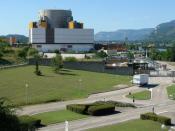Nuclear power plants provide about 17 percent of the world's electricity.
Some countries depend more on nuclear power for electricity than others. In
France, for instance, about 75 percent of the electricity is generated from nuclear
power, according to the International Atomic Energy Agency. In the United States,
nuclear power supplies about 15 percent of the electricity overall, but some states
get more power from nuclear plants than others. There are more than 400 nuclear
power plants around the world, with more than 100 in the United States.
Uranium is a fairly common element on Earth and was incorporated into the
planet during the planet's formation. Uranium is originally formed in stars. Old stars
explode, and the dust from these shattered stars aggregated together to form our
planet. Uranium-238 has an extremely long half-life (4.5 billion years) and,
therefore, is still present in fairly large quantities. U-238 makes up 99 percent of
the uranium on the planet.
Uranium-235 makes up about 0.7 percent of the
remaining uranium found naturally, while uranium-234 is even more rare and is
formed by the decay of uranium-238. (Uranium-238 goes through many stages or
alpha and beta decay to form a stable isotope of lead, and U-234 is one link in that
chain.) Uranium-235 has an interesting property that makes it useful for both
nuclear power production and for production. U-235 decays naturally, just as
U-238 does, by alpha radiation. U-235 also undergoes spontaneous fission a small
percentage of the time. However, U-235 is one of the few materials that can
undergo induced fission. If a free neutron runs into a U-235 nucleus, the nucleus
will absorb the neutron without hesitation, become unstable and split immediately.
To build a nuclear reactor, what you need is some mildly enriched uranium.
Typically, the uranium is...



O_ o
Have you considered that you need high safety regulations on how to dispose the nuclear waste which is created?
0 out of 0 people found this comment useful.